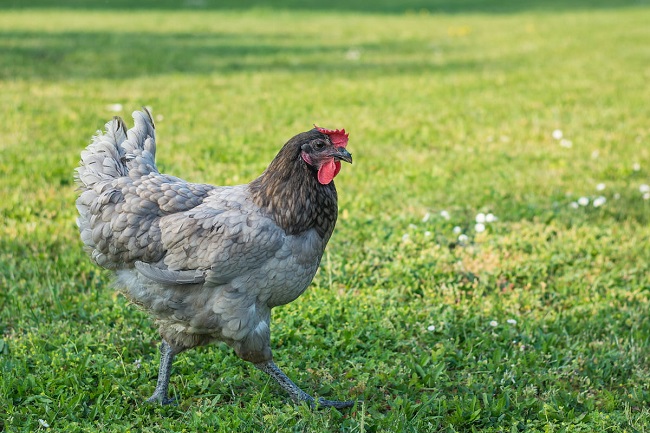Chickens, with their variety of shapes, sizes, and colors, have captivated hobbyists and farmers alike. Among the spectrum of feather colors, grey chicken breeds offer a unique appeal with their elegant and understated beauty.
This guide dives into various grey chicken breeds, discussing their history, characteristics, and what makes them a coveted choice for chicken enthusiasts.

Some Top Grey Chicken Breed
Here are some of the top grey chicken breeds:
Read Also:
Lavender Orpington
The Lavender Orpington, also known as the self-blue Orpington, is one of the most popular grey chicken breeds. Originating in England, they’re loved for their fluffy plumage, calm temperament, and good egg-laying abilities.
Their feathers are not just grey but have a unique lavender hue that gives the breed its name.
Plymouth Rock (Barred Rock)
The Plymouth Rock, specifically the Barred Rock variety, is an American breed known for its striking grey and white striped plumage.
They are a dual-purpose breed, appreciated both for their egg-laying prowess and their ample size for meat production. Their docile nature makes them a favorite in backyard coops.
Blue Andalusian
The Blue Andalusian, native to Andalusia in Spain, is renowned for its slate-blue to grey feathers. They are a highly active breed, known for their strong foraging skills and impressive egg-laying capabilities.
They possess a rare genetic trait that results in each bird displaying a slightly different shade of grey.
Araucana
Araucanas are a fascinating breed from South America, best known for producing blue eggs. They come in many colors, including a captivating blue-grey. This breed is often confused with Ameraucanas and Easter Eggers, both of which can also lay blue eggs.
Blue Cochin
The Blue Cochin, originating from China, is prized for its large size and abundance of soft, fluffy feathers. Their feather color can range from light grey to a deep slate blue. Despite their imposing size, they are known for their gentle and friendly temperament.
Dorking
The Dorking, one of the oldest known chicken breeds, sports a silver-grey variety with a distinctly patterned plumage. Originating from Italy and further developed in Britain, Dorkings are admired for their tender meat and are decent egg layers as well.
Grey Junglefowl
The Grey Junglefowl, while not a traditional domestic breed, deserves a mention. Native to India, this wild bird is believed to be one of the primary ancestors of domestic chicken breeds. The male’s plumage is a mix of grey and white, with vibrant orange to red accents.
Caring for Grey Chicken Breeds
Just like other chickens, grey chicken breeds require a balanced diet, secure housing, and regular health check-ups.
While their care needs are quite standard, some breeds with larger or more abundant feathers may require additional grooming to keep their plumage in good condition.
Read Also:
Conclusion
Grey chicken breeds, with their range of hues and patterns, add a touch of elegance to any backyard or farm. Each breed carries its unique history and set of characteristics, making them fascinating to own and observe.
Whether you’re drawn to the lavender tint of an Orpington, the unique patterns of a Barred Rock, or the deep blue-grey of a Cochin, these birds promise a rewarding and enriching chicken-keeping experience.
























